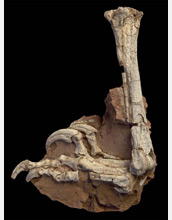News Release 10-158
"Stocky Dragon" Dinosaur Terrorized Late Cretaceous Europe
Balaur bondoc used extendable claws to attack and tear apart prey

The fossilized hindlimb of Balaur bondoc is shown.
August 30, 2010
Listen to an audio program on the Balaur bondoc discovery.
This material is available primarily for archival purposes. Telephone numbers or other contact information may be out of date; please see current contact information at media contacts.
Paleontologists have discovered that a close relative of Velociraptor hunted the dwarfed inhabitants of Late Cretaceous Europe, an island landscape largely isolated from nearby continents.
While island animals tend to be smaller and more primitive than their continental cousins, the theropod Balaur bondoc was as large as its relatives on other parts of the globe, and demonstrated advanced adaptations including fused bones and two terrifyingly large claws on each hind foot.
A team of Paleontologists from the University of Bucharest and the American Museum of Natural History (AMNH) present their findings as the cover story of the Aug. 31 issue of the Proceedings of the National Academy of Sciences.
"While we would expect that there were carnivorous animals in these faunas, finding one as unusual as Balaur is thrilling and is testament to the unusual animals found on islands today and in the past," said paleontologist and co-author Mark Norell of AMNH.
The Balaur bondoc bones (Balaur from an archaic Romanian term for dragon, bondoc meaning stocky) represent the most complete predator skeleton paleontologists have found in sediments from the end of the Mesozoic in Europe.
While few in number, the fossils reveal an animal perhaps six to seven feet long with a stockier build than similarly sized Velociraptors elsewhere on the globe, but numerous similarities to the more familiar predator.
"Although Balaur is so extremely divergent morphologically, it is closely related to animals like Velociraptor and the feathered dinosaurs in China," said lead author Zoltan Csiki, a paleontologist at the University of Bucharest. "The finding indicates that this area of the world, despite its archipelago geography, had at least intermittent faunal connections with the mainland up to the end of the Cretaceous. This connection was not really acknowledged until very recently."
The Balaur research was funded in part by the American Museum of Natural History, the National Science Foundation through grant EAR-0207664, the Columbia University Department of Earth and Environmental Sciences, the Romanian National University Research Council, and Richard and Lynn Jaffe.
For more information about the discovery, read the AMNH press release.
-NSF-
-
Play Audio
Researchers discuss the Balaur bondoc discovery in an audio program with NSF.
Credit and Larger Version -
A reconstruction shows the skeletal anatomy of Balaur bondoc.
Credit and Larger Version
Media Contacts
Joshua A. Chamot, NSF, (703) 292-7730, email: jchamot@nsf.gov
Michael Walker, American Museum of Natural History, (212) 769-5766, email: mwalker@amnh.org
Kristin Phillips, American Museum of Natural History, (212) 496-3419, email: kphillips@amnh.org
Program Contacts
H. Richard Lane, NSF, (703) 292-8551, email: hlane@nsf.gov
Principal Investigators
Mark Norell, American Museum of Natural History, (212) 769-5804, email: norell@amnh.org
Co-Investigators
Zoltan Csiki, University of Bucharest, +40722844810, email: zoltan.csiki@g.unibuc.ro
The U.S. National Science Foundation propels the nation forward by advancing fundamental research in all fields of science and engineering. NSF supports research and people by providing facilities, instruments and funding to support their ingenuity and sustain the U.S. as a global leader in research and innovation. With a fiscal year 2023 budget of $9.5 billion, NSF funds reach all 50 states through grants to nearly 2,000 colleges, universities and institutions. Each year, NSF receives more than 40,000 competitive proposals and makes about 11,000 new awards. Those awards include support for cooperative research with industry, Arctic and Antarctic research and operations, and U.S. participation in international scientific efforts.
Connect with us online
NSF website: nsf.gov
NSF News: nsf.gov/news
For News Media: nsf.gov/news/newsroom
Statistics: nsf.gov/statistics/
Awards database: nsf.gov/awardsearch/
Follow us on social
Twitter: twitter.com/NSF
Facebook: facebook.com/US.NSF
Instagram: instagram.com/nsfgov


